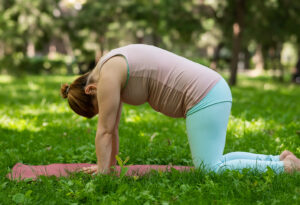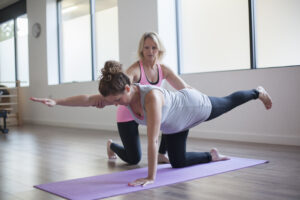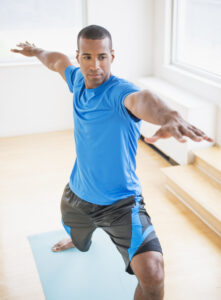With up to 85% of Americans experiencing back pain at some time in their lives, it is safe to assume that most people are at risk. Back pain can be debilitating and impact the quality of one’s life by reducing function and activity. This is especially true as we age, and our spines become more susceptible to ‘wear and tear’ meaning arthritis will set into the spine.
Spine core exercises, stretching and balance exercises to prevent falls have all been shown in research to improve blood flow, increase strength, prevent injury and improve balance as we get older.
The following exercises can be helpful to older adults and should be done at least three times per week. Some additional activities include biking, swimming, walking, yoga and tai chi.
1. Knee to chest back stretch
Lay down flat on the bed or floor, put a small pillow under your head and lower back. Bring your right knee to your chest keeping your left leg straight. Use your hands to bring your knee closer to your chest to your tolerance. Count to five, then release returning your leg to the starting position. Repeat the movement on the opposite side. Do this five times on each side.
2.Pelvic tilts
Lie on your back, knees bent and feet flat, then arch your back and push your belly upwards. Hold for five seconds and repeat with two sets of 10 reps.
3.Bridges
Bridges strengthen your back, buttocks, and hamstring muscles. Lie on your back with your knees bent and gently lift your hips up, keeping your feet and shoulders flat and in place. Hold it for five seconds and repeat 10 times.
4.Cat/cow stretch
This is a yoga pose to improve spine flexibility. Begin on your hands and knees with your knees hip-width apart. Arch your back up (cat) and pull your belly button up. Then relax your muscles bringing your belly down toward the floor and lifting your hips (cow). Repeat five times.
knees hip-width apart. Arch your back up (cat) and pull your belly button up. Then relax your muscles bringing your belly down toward the floor and lifting your hips (cow). Repeat five times.
5. Sit backs
Sitting back helps strengthen your back and abdominals. Sit on the floor or bed with your knees bent and back straight. Cross your arms over your chest. Keeping your back straight, knees bent and feet on the ground, lean back using your abdominals about 10-15 degrees. Only go back as far as your comfort level will allow. Come back to the initial position and repeat 10 times.
6. Standing reverse leg lifts
These exercises help work your glutes, back and lower abdominals. Stand up straight with your feet hip-width apart and your hands on a chair or countertop in front of you. Lift one leg and extend it out behind you. Only go as far as is comfortable to not cause any pain. Hold this position for five seconds and repeat on each side five times.
7. Sit to stand
This will help improve balance. Be sure to do this with a chair that has arms or near the table to support you in case you lose your balance. Sit in a chair then simply stand up. Do this 10 times.
8. Bird dog
This is a yoga pose that improves mobility as well as strength in the back and abdominals.

Start on your hands and knees on the floor or bed. Lift and extend one leg out behind you making your leg as straight as you comfortably can. At the same time lift your opposite arm in front of you. Hold for three to five seconds and then lower your arm and leg, then repeat on the opposite side.
9. One leg stands
This exercise will also help improve balance. Be sure to do this near a table or wall to support you if you lose your balance. Holding to a chair or table in front of you, bend one knee up and raise that leg off the floor while balancing on the other leg. Repeat on each side five times.
10. Warrior pose
 This is a Yoga position that can help improve posture and mobility, as well as reduce pain. You may keep a chair nearby in case you lose your balance. Stand on a soft surface with your feet apart, turn your right foot so your toes point straight out to the right and lift both arms to shoulder height. Bend your right leg, left leg staying straight, hold for 10 seconds and repeat five times.
This is a Yoga position that can help improve posture and mobility, as well as reduce pain. You may keep a chair nearby in case you lose your balance. Stand on a soft surface with your feet apart, turn your right foot so your toes point straight out to the right and lift both arms to shoulder height. Bend your right leg, left leg staying straight, hold for 10 seconds and repeat five times.
With back pain being a prevalent issue for many older adults, these targeted exercises focusing on flexibility, strength and balance offer a proactive approach to mitigate the risks associated with aging and spinal deterioration. By investing time in these exercises, individuals are investing in themselves. Following these tips can help to alleviate potential back problems, fostering a better quality of life as you age.
David J. BenEliyahu, DC, FICC
Administrative Director, Back & Neck Pain Center at Mather Hospital

